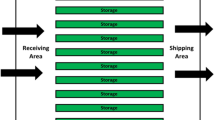Abstract
Because of intensive capital investment in semiconductor manufacturing, the priority mix decision plays a critical role for effective administration. The potential value of products, efficiency in the deployment of equipment, and characteristics of cash flow are inherently difficult to be precisely defined and determined by a decision maker. The main objective in this study is therefore to construct an analytical approach for dealing with the aforementioned managerial problems under subjective judgment environments. Thus, we utilized a fuzzy analytic hierarchy process method to deal with uncertainty. Of primary concern are the criteria of product, equipment efficiency, and finance, and detailed criteria are catered to the requirement for further analysis. Finally, a priority mix of strategic alternatives represented by a priority index can be evaluated. A performance ranking of priority mixes can then be generated. The results provide guidance to select strategies for accepting orders with the consideration of manufacturing efficiency and the aspects of product, equipment efficiency and finance. The model is easily understandable and can be followed by administrators to determine the most suitable priority mix for a fabrication process.
Similar content being viewed by others
References
Atherton LF, Atherton RW (1995) Wafer fabrication: factory performance and analysis. Kluwer, Boston
Adamo JM (1980) Fuzzy decision trees. Fuzzy Sets Syst 4(3):207–220
Boender CGE, de Graan JG, Lootsma FA (1989) Multiple-criteria decision analysis with fuzzy pairwise comparisons. Fuzzy Sets Syst 29:133–143
Chen SM (1996) Evaluating weapon systems using fuzzy arithmetic operations. Fuzzy Sets Syst 77:265–276
Cheng CH (1996) Evaluating naval tactical missile systems by fuzzy AHP based on the grade value of membership function. Eu J Oper Res 96:343–350
Cheng CH (1999) Evaluating weapon systems using ranking fuzzy numbers. Fuzzy Sets Syst 107:25–35
Cheng CH, Yang KL, Hwang CL (1999) Evaluating attack helicopters by AHP based on linguistic variable weight. Eur J Oper Res 116:423–435
Chou TY, Liang GS (2001) Application of a fuzzy multi-criteria decision-making model for shipping company performance evaluation. Maritime Policy Manage 28(4):375–392
Chi SC, Kuo RJ (2001) Examination of the influence of fuzzy analytic hierarchy process in the development of an intelligent location selection support system of convenience store. In: Proceedings of the IFSA World Congress and 20th NAFIPS International Conference 3:1312–1316
Chung SH, Lee AHI, Pearn WL (2005) Product mix optimization for semiconductor manufacturing based on AHP and ANP analysis. Int J Adv Manuf Technol, DOI: 10.1007/s00170-003-1956-8
Dubois D, Prade H (1978) Operations on fuzzy number. Int J Syst Sci 9(6):613–626
Gupta MM, Saridis GN, Gaines BR (1977) Fuzzy automata and decision processes. Elsevier, New York
Klir GI, Yan B (1995) Fuzzy sets and fuzzy logic theory and applications. Prentice-Hall, London
Kuo RJ, Chi SC, Kao SS (2002) A decision support system for selecting convenience store location through integration of fuzzy AHP and artificial neural network. Comput Ind 47:199–214
Laarhoeven PJM, Pedrycz W (1983) A fuzzy extension of Saaty’s priority theory. Fuzzy Sets Syst 11:229–241
Leachman RC, Hodges DA (1996) Benchmarking semiconductor manufacturing. IEEE Trans Semiconductor Manuf 9(2):158–169
Lee ES, Li RL (1988) Comparison of fuzzy numbers based on the probability measure of fuzzy events. Comput Math Appl 15:887–896
Liang GS, Wang MJ (1994) Personnel selection using fuzzy MCDM algorithm. Eu J Oper Res 78:22–33
Lee HT, Chen SH, Kang HY (2002) Multicriteria scheduling using fuzzy theory and tabu search. Int J Prod Res 40(5):1221–1234
Mabuchi S (1988) An approach to the comparison of fuzzy subsets with an α-cut dependent index. IEEE Trans Syst Man Cybernetics SMC 18(2):264–272
Mon DL, Cheng CH, Lu HC (1995) Application of fuzzy distributions on project management. Fuzzy Sets Syst 11:229–241
Murtaza MB (2003) Fuzzy-AHP application to country risk assessment. Am Bus Rev 21(2):109–116
Saaty TL (1980) The analytic hierarchy process. McGraw-Hill, New York
SEMI (2002) Provisional guideline for definition and calculation of overall factory efficiency (OFE) and other associated factory-level productivity metrics. SEMI Draft Document 3454. Mountain View
Stevenson WJ (2002) Operations management. McGraw-Hill, New York
Tecnomatix Technologies Ltd (2001) EM-PLANT objects manual. Tecnomatix Software Company, Germany
Tsaur SH, Tzeng GH, Wang KC (1997) Evaluating tourist risks from fuzzy perspectives. Ann Tourism Res 24(4):796–812
Tsaur SH, Chang TY, Yen CH (2002) The evaluation of airline service quality by fuzzy MCDM. Tourism Manage 23:107–115
Gupta MM, Saridis GN, Gaines BR (1977) Fuzzy automata and decision processes. Elsevier, New York
Uzsoy R, Lee CY, Martin-Vega LA (1992) A review of production planning and scheduling models in the semiconductor industry, part I: system characteristics, performance evaluation and production planning. IIE Trans Sched Logist 24(4):47–61
Yagar RR (1978) On a general class of fuzzy connective. Fuzzy Sets Syst 4:235–242
Yu CS (2002) A GP-AHP method for solving group decision-making fuzzy AHP problems. Comput Oper Res 29:1969–2001
Zadeh LA (1965) Fuzzy sets. Inf Control 8:338–353
Zahedi F (1986) The analytic hierarchy process – a survey of the method and its applications. Interfaces 16:96–108
Author information
Authors and Affiliations
Corresponding author
Rights and permissions
About this article
Cite this article
Lee, A., Kang, HY. & Wang, WP. Analysis of priority mix planning for the fabrication of semiconductors under uncertainty. Int J Adv Manuf Technol 28, 351–361 (2006). https://doi.org/10.1007/s00170-004-2369-z
Received:
Accepted:
Published:
Issue Date:
DOI: https://doi.org/10.1007/s00170-004-2369-z




